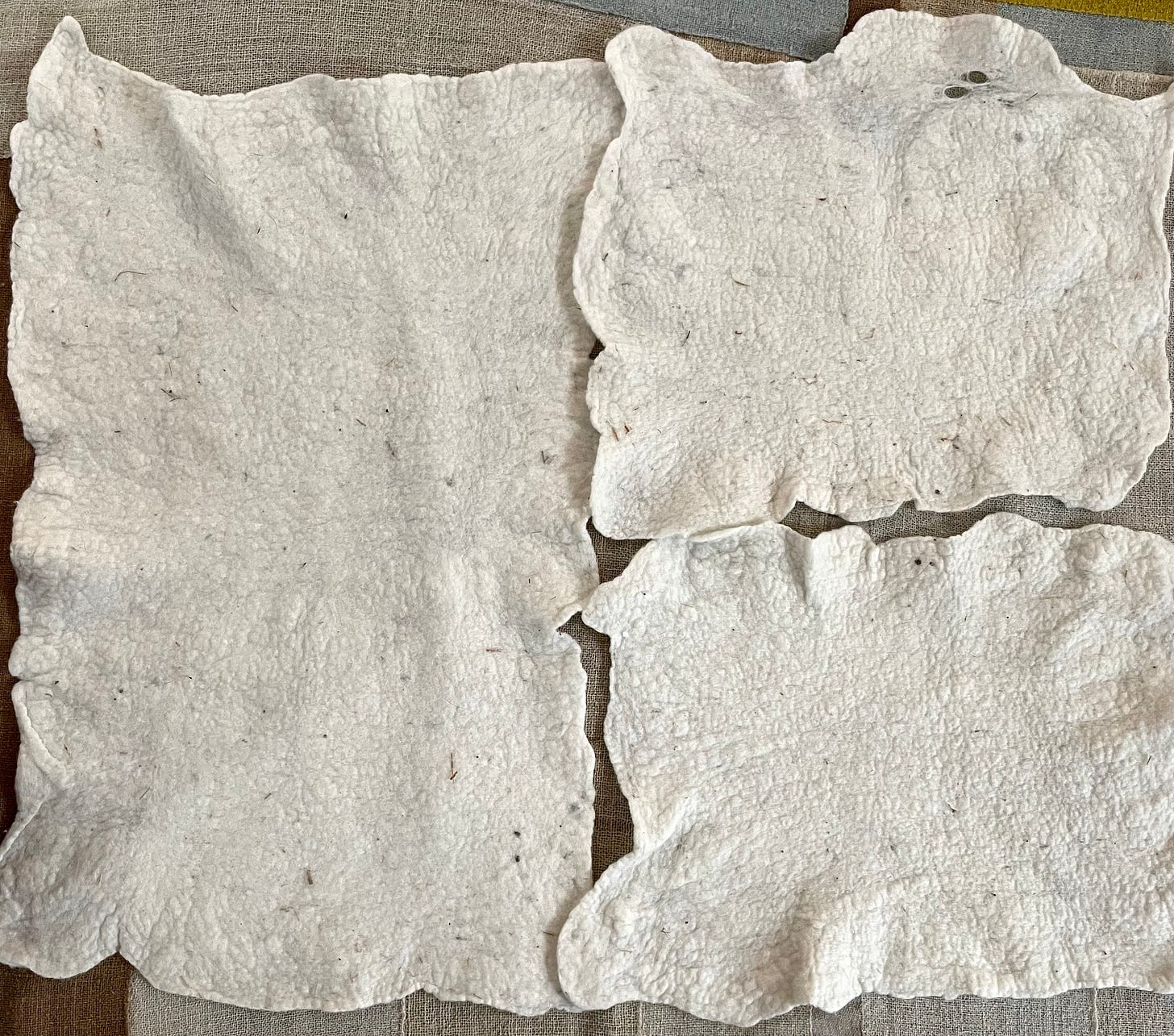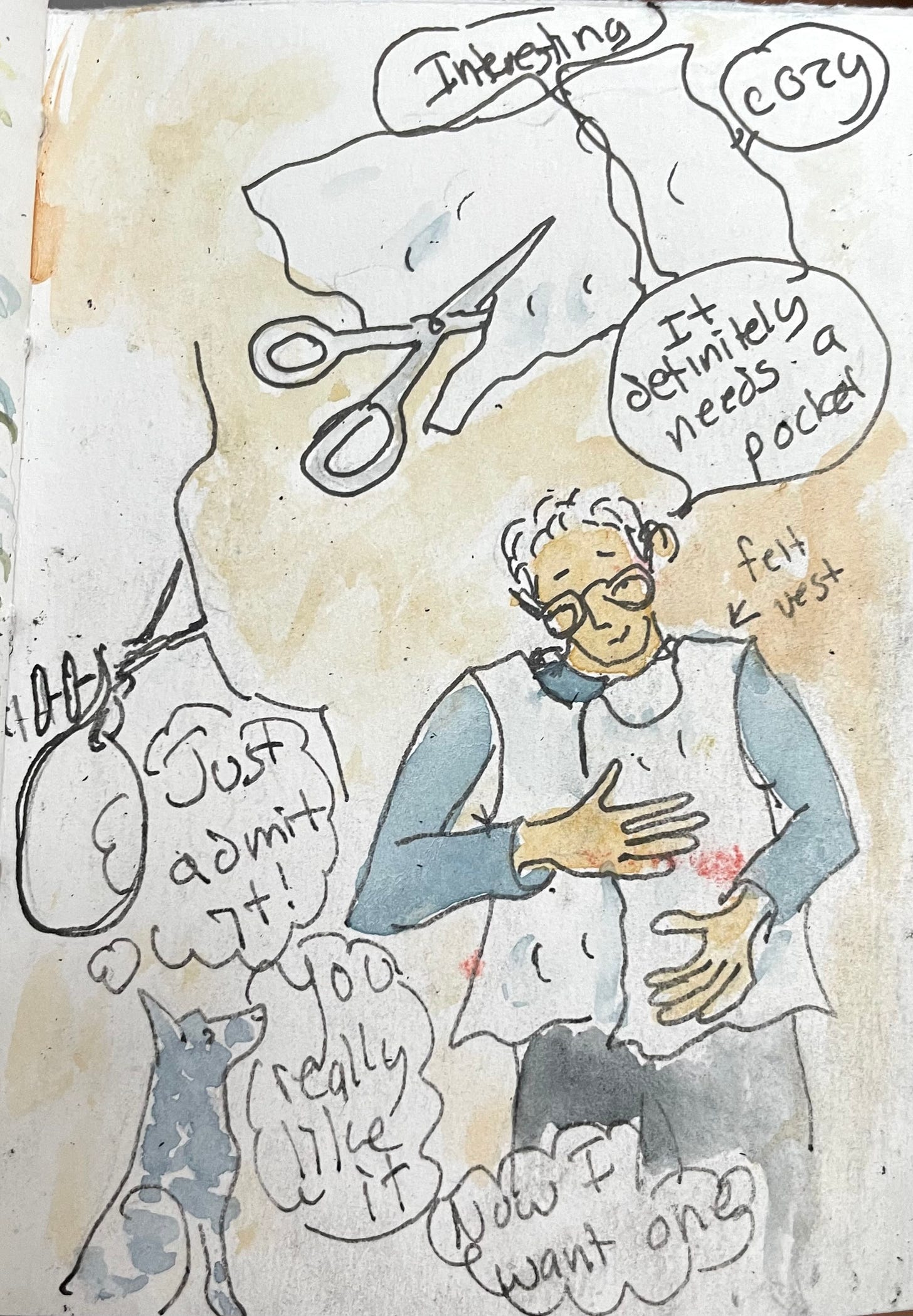So what could I do but felt one?1
It needed a pile of carded wool—
—a million ideas—


—and some water.
Also time.
And a bit of gumption I found somewhere or other.
Maybe in the wool itself.
What with the hole in the upper right, plant material scattered throughout and edges that are anything but straight, these pieces of felt are neither fancy or fine.
But apparently they are exactly what I needed. 2
Just why the making of this garment has delighted me so I cannot say, but start to finish it’s been a treat—even the sloppy wet bits I thought I’d have to endure.
Indeed I was so charmed by the whole thing that I made some videos in case you want to give it a go—or at least see the miracle of wool in action.3 Feel free to scroll by of course (they are more informative than elegant and there’s much better info on YouTube), but for the curious, here’s what I did.
Spread a great big plastic bag4 across the workbench and propped it up at the sides and corners with rolled up towels (to turn said workbench into an impromptu basin).
Unrolled four carded batts and laid them on the plastic in two layers: two horizontally and two vertically. (More layers of thin batts might have made more even felt, but apparently I was feeling casual).
Filled a container with water as hot as my hands could stand and added a squirt of dish detergent.
Slowly poured the liquid over the batts, pressing until all the dry fleece was wet and flattish.
Wiggled and waggled and agitated the wet mess until the fibers started to stick together.
Periodically turned the plastic bag to work from different directions, gradually putting more energy into the wiggling. When I could pick up a corner without it falling apart, I flipped it over and continued on the other side (a bit like pie dough with the intent to make a very tough crust).
Rubbed and rubbed —around the edges, across the middle—squishing and squashing with increasing vigor until the surface grew puckered and it felt like felt. It took about fifteen or twenty minutes per piece.5
Repeated this twice more.
When all three pieces were in about the same state, I threw them in the washing machine for a cold water rinse-and-spin “toughening up” cycle, then laid them flat to dry.
Stats: I began with about 225 grams (8 oz) of wool carded into fifteen batts. Each of the smaller pieces of felt used four batts, the larger one took seven. I forgot to measure the finished dimensions but at a guess the small ones were approximately 14” x 18” and the big one 18” x 24”.
The finished vest weighs 200 grams (7.14 oz) and it feels like wearing a cloud. Or at least how I imagine wearing a cloud would be (without the moisture). In other words, I hardly know it is on except that I’m warm rather than slightly chilled (my usual state). And when I slip my hand into the pocket it feels like a bowl of cozy whipped cream laced with caraway seeds.
I didn’t start with a pattern, but a knitted vest with a decent shape provided an approximate shoulder width and armhole depth; I laid it on top of the felt pieces and cut off the bits that weren’t vest.


Of course there were also bits of vest that weren’t felt (if it fit in one direction it didn’t in the other), so sewed armhole scraps into the gaps.
Rather than overlap the seams I butted the cut edges and joined them with a bar and cross stitch—
— then needle felted more of the same fleece over the top for strength and to make the seams disappear.6
There were a million tiny decision-making moments throughout, but this post is already long enough so I won't bore you with the minutiae—
—other than to crow just teeny bit about how, after three days of sorting through my collection of beautiful buttons, going back and forth and round and round (as it were), about shape size and color and material—
— it occurred to me to felt some.
And now I’m seriously smitten. Who knew?7
Beryl, of course, has been extremely helpful through all of it.
Not only does she make my photos better (she’s a fashion icon don’t cha know, with a color palette I continually try to emulate)—


—but she also talked me out of climbing onto the roof to do unnecessary shoveling when it was clear I’d rather be working on the vest.
Well she talked me out of the shoveling part, but I did have to go up there when the snow and cold turned to rain —and the ice dams definitely needed to be chopped away.
She was not impressed with the racket I made with the hatchet, but who wants to live under a reservoir?
Anyway, if we needed to splash around in snowmelt (which we apparently did), it was much easier to do that at the dog park/ field/pond than get Beryl interested in climbing the ladder to the roof.
But we’re home now. Dry and cozy.
So where was I???
Oh yes! Doing that other thing I love to do. Except now Beryl wants me to close the computer and go for another walk.
It’s a fine idea to be sure.
Think she might want to go back to dog park lake?
Remember to comment with the button above rather than by hitting reply, for if you choose the latter I won’t see your lovely words.
And if you know anyone who might enjoy these meanderings—or likes to make things out of felt— please do click the button below and see what they think.
felt: noun, verb, past participle of feel. My apologies for playing with them all. It’s just that, as my mother used to say when doing something potentially annoying, “I just couldn’t resist!”
This plan actually began with an idea to use the wool as the insulating layer in some kind of quilted structure, the felting part just a minor step that would make the open airy batts into something easier to work with. And maybe I’ll still do that some day because I think wool batting would not only be fantastically warm and light but also delicious to stitch through.
Wool is truly a miracle fiber —stretchy, resilient, warm, light, renewable, compostable— all the things polyester pretends to be and isn’t. If you’re a wool lover too, or want to know more about it, or just hang with other people who are obsessed with this miraculous fiber, I highly recommend Clara Parkes’ The Wool Channel where she celebrates and advocates for wool at every level.
Do you have these— great big plastic bags that arrived wrapped around something and are too potentially useful to recycle? I usually think of them as tapestry shipping bags, but it turns out they’re perfect for turning a countertop into an impromptu sink.
Felting time is based entirely on this particular fleece (Debouillet/Targhee), and these circumstances. Every fleece felts differently. Some don’t felt at all (down breeds I’m looking at you). So if you’re going to try this, know what you’re working with or at least experiment with a small handful of the fiber you have to make sure it’ll become something you like.
Needle Felting—another process about which there is more information on the internet than you can possibly imagine so I’ll leave you to dive into that rabbit hole on your own. At an elemental level it is as easy as it looks in the video: stab stab stab the needle into the fiber (as you can see I used a big natural sponge to stab into because that is what I have, and it worked a treat). It can also be extremely sophisticated—the sculptures people make with needle felting are astonishing. I think it could get kind of addictive…
Well, I’m sure lots of people already know about felting buttons and I bet there are some really interesting techniques out there. It’s just that I’d never thought of it, seen it or done it, so got to experience all the pleasure of, as Elizabeth Zimmerman said, “unventing it.”

























How I do love this stylin earthy garment-especially the asymmetrical lapels and the big jaunty pocket that could contain all manner of magical tools🤎
Wonderful!!!! I’d like to see some embroidery on it- I am inspired